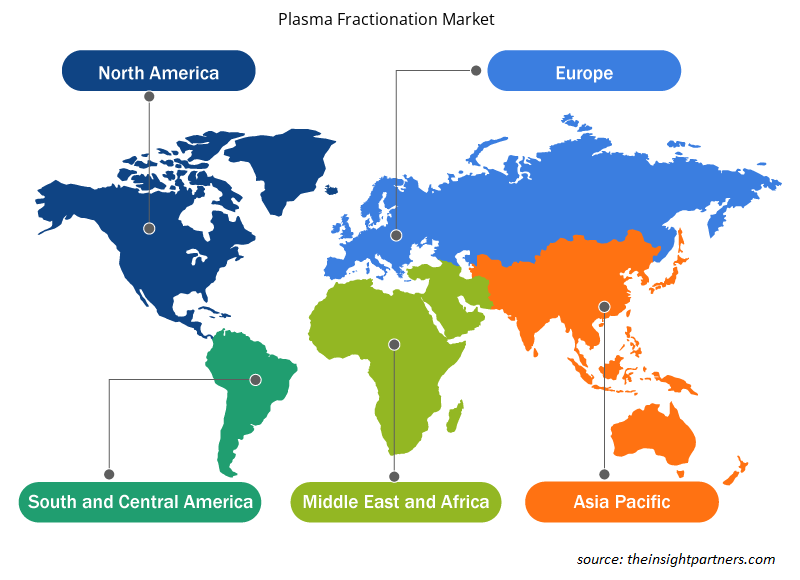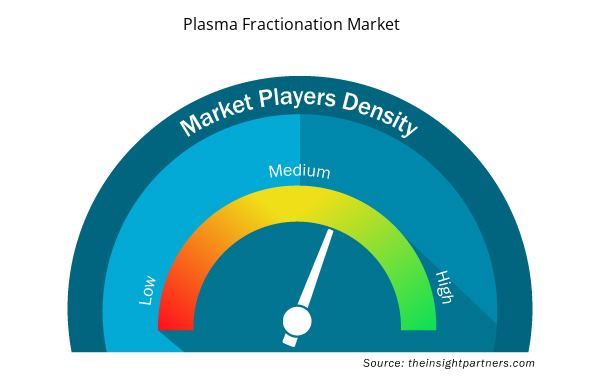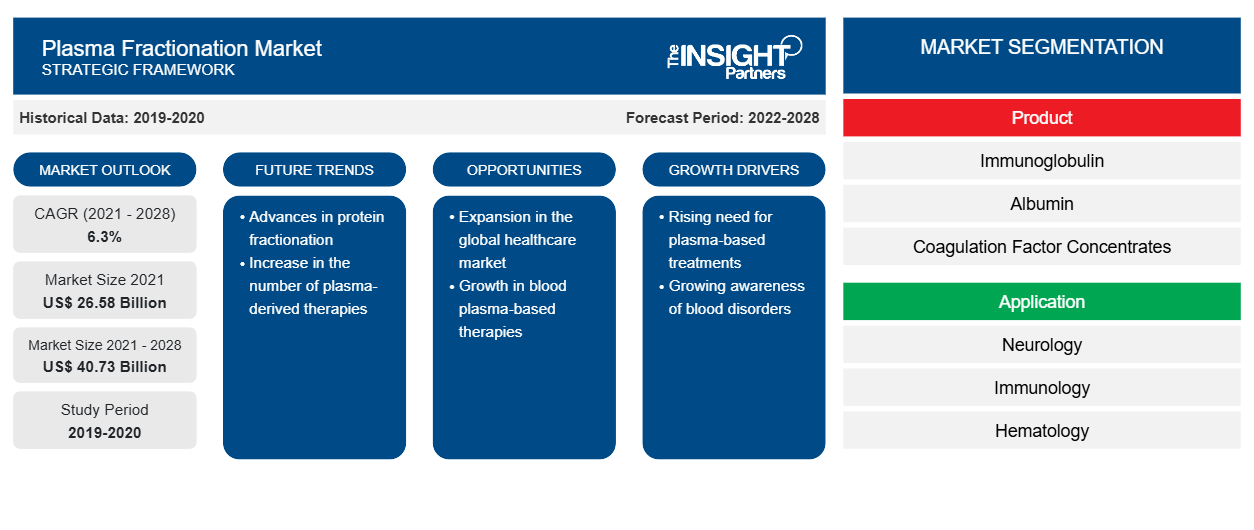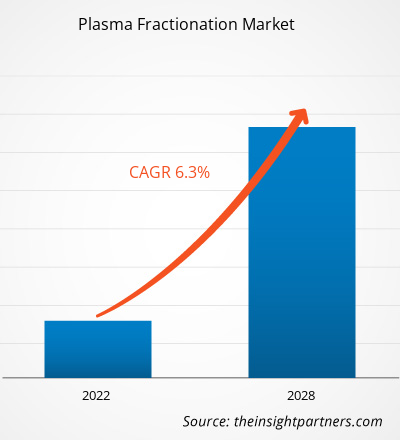[Forschungsbericht] Der Markt für Plasmafraktionierung soll von 26.575,83 Millionen US-Dollar im Jahr 2021 auf 40.731,98 Millionen US-Dollar im Jahr 2028 wachsen; der Markt für Plasmafraktionierung soll von 2021 bis 2028 mit einer durchschnittlichen jährlichen Wachstumsrate von 6,3 % wachsen.
Analystenperspektive
Das Wachstum des globalen Plasmafraktionierungsmarktes wird voraussichtlich aufgrund der zunehmenden Verwendung von Plasmatherapie zur Behandlung neuartiger Krankheiten und der zunehmenden Anwendung von Plasma zur Entwicklung therapeutischer Produkte zunehmen. Darüber hinaus ist während der COVID-19-Pandemie die Nachfrage nach Plasmatherapie sprunghaft gestiegen, was das Wachstum des Plasmafraktionierungsmarktes begünstigt hat. Darüber hinaus haben die zunehmenden Fälle von Autoimmunerkrankungen, Infektionskrankheiten und Immunerkrankungen wichtige Wachstumschancen für das Wachstum des Marktes geboten. Das verbesserte Wissen über die Vorteile der Plasmatherapie hat die Plasmafraktionierung in Industrieländern erhöht. Gleichzeitig unternehmen Entwicklungsländer Anstrengungen, um ihre Fähigkeiten zur Plasmagewinnung zu verbessern und den Einsatz der Plasmatherapie auszuweiten. So verfügt das Land nach Angaben der indischen Regierung über 2.700 Blutbanken, die jährlich fast 10–11 Millionen Bluteinheiten sammeln. Die Statistiken zeigen jedoch, dass es im Land oft einen Mangel an Plasma gibt und der Verbrauch von Plasmaderivaten pro Kopf im Vergleich zu Industrieländern geringer ist. Das wachsende Bewusstsein und die steigenden Investitionen in die Plasmafraktionierung in den Industrieländern haben jedoch den Weg für ein Wachstum der Plasmafraktionierung auf dem Markt in den Jahren 2021–2028 geebnet.
Marktübersicht
Der Prozess der Trennung verschiedener Bestandteile des Blutplasmas wird als Plasmafraktionierung bezeichnet. Die getrennten Bestandteile werden verwendet, um verschiedene therapeutische Plasmaprodukte herzustellen, die zur Behandlung verschiedener Erkrankungen eingesetzt werden können. Immunglobulin, Gerinnungsfaktoren, Albumine und Inhibitoren sind nur einige der häufig verwendeten Plasmaprodukte. Das Wachstum des Plasmafraktionierungsmarktes wird hauptsächlich durch Faktoren wie die zunehmende Anwendung der Plasmatherapie und die aktive Teilnahme der beteiligten Unternehmen an Marktentwicklungen vorangetrieben, die das Marktwachstum vorantreiben. Die Verfügbarkeit rekombinanter oder nicht aus Plasma gewonnener Produkte behindert jedoch das Wachstum des Marktes. Der globale Plasmafraktionierungsmarkt ist nach Produkt, Anwendung und Endverbraucher segmentiert. Geografisch wird der Markt in Nordamerika, Europa, Asien-Pazifik, Naher Osten und Afrika sowie Süd- und Mittelamerika unterteilt. Die Region Nordamerika hält den größten Marktanteil am Plasmafraktionierungsmarkt, und der Asien-Pazifik-Raum gilt als die am schnellsten wachsende Region.
Passen Sie diesen Bericht Ihren Anforderungen an
Sie erhalten kostenlose Anpassungen an jedem Bericht, einschließlich Teilen dieses Berichts oder einer Analyse auf Länderebene, eines Excel-Datenpakets sowie tolle Angebote und Rabatte für Start-ups und Universitäten.
- Holen Sie sich die wichtigsten Markttrends aus diesem Bericht.Dieses KOSTENLOSE Beispiel umfasst eine Datenanalyse von Markttrends bis hin zu Schätzungen und Prognosen.
Markttreiber
Zunehmende Anwendung der Plasmatherapie
Blutplasma ist eine der neuen Behandlungsmethoden für verschiedene chronische Krankheiten. Plasma enthält wichtige Bestandteile wie Proteine, Albumin , Globuline, Fibrinogen, Gerinnungsfaktoren und -inhibitoren und mehr. Es wird häufig bei Blutkrebs, COVID19, Vorhofflimmern, Leukämie und anderen Krankheiten eingesetzt. Das Plasma wird durch Plasmafraktionierung vom gespendeten Blut getrennt. Die Aufsichtsbehörden erteilen auch die erforderlichen Genehmigungen für die Verwendung von Plasma in Behandlungsprozessen. So erteilte die US-amerikanische Food and Drug Administration (USFDA) im August 2020 die Notfallzulassung (EUA) für die Behandlung von COVID-19 mit Rekonvaleszentenplasma. Darüber hinaus veröffentlichte die USFDA im Februar 2021 eine aktualisierte Leitlinie für die Plasma-EUA für COVID19. Es ist also zu erwarten, dass eine aktive Beteiligung und Genehmigung durch die Aufsichtsbehörden und die Regierung die Verwendung von Blutplasma fördern wird. Das Blutplasma kann bis zu einem Jahr gelagert werden, indem es innerhalb von 24 Stunden nach der Blutspende eingefroren wird, um die wertvollen Gerinnungsfaktoren zu schützen, und kann nach dem Auftauen verwendet werden. In allen Ländern der Welt gibt es viele Blutbanken, die Zugang zu Gesundheitsdienstleistern haben und von verschiedenen Regierungen und anderen Organisationen finanziert werden. So bewilligte die American Association of Blood Banks (AABB) im Jahr 2021 beispielsweise Mittel für Forschungsprojekte wie „Entwicklung einer immuntherapieresistenten Hämatopoese zur Behandlung einer hochriskanten akuten myeloischen Leukämie“ (von Pietro Genovese, BSc, MSc, Ph.D., Assistenzprofessor für Pädiatrie, Gentherapieprogramm, Dana-Farber/Boston Children's Cancer and Blood Disorder Center, Dana-Farber Cancer Institute), „Neue Ansätze zur Untersuchung und Behandlung alloantikörpervermittelter Erkrankungen infolge von Bluttransfusionen“ (von Simon J. Cleary, Ph.D., Postdoktorand, Lungenmedizin, University of California) und andere. Aus den oben genannten Gründen wird der Markt im Prognosezeitraum mit der Blutplasmafraktionierung zusammenhängen.
Segmentanalyse
Der globale Markt für Plasmafraktionierung ist nach Produkt, Anwendung und Endverbraucher segmentiert. Basierend auf dem Produkt ist der Markt in Immunglobulin, Albumin, Gerinnungsfaktorkonzentrate, Proteaseinhibitoren und andere segmentiert. Das Immunglobulinsegment wird im Jahr 2021 wahrscheinlich den größten Marktanteil haben. Darüber hinaus wird erwartet, dass es im Zeitraum 2021–2028 die höchste CAGR auf dem Markt verzeichnet. Aufgrund der zunehmenden Verbreitung von Infektionskrankheiten und der aktiven Unterstützung der Regierung und der Aufsichtsbehörden bei Produktentwicklungen und -zulassungen wird erwartet, dass dieses Segment im Prognosezeitraum erheblich zum Markt beitragen wird. So erteilte die US-amerikanische Food and Drug Administration (FDA) im Mai 2021 eine Notfallzulassung für die experimentelle monoklonale Antikörpertherapie „Sotrovimab“ zur Behandlung von leichtem bis mittelschwerem COVID-19 bei Erwachsenen und pädiatrischen Patienten. Darüber hinaus ist das Immunglobulin in intravenöses Immunglobulin, subkutanes Immunglobulin und andere unterteilt.
Basierend auf der Anwendung ist der Markt in Neurologie, Immunologie, Hämatologie, Intensivmedizin, Pulmonologie und andere segmentiert. Im Jahr 2021 hielt das Segment Neurologie den größten Marktanteil am Markt für Plasmafraktionierung. Es wird jedoch erwartet, dass das Segment Hämatologie von 2021 bis 2028 aufgrund der zunehmenden Erkennung und Diagnose verschiedener Erkrankungen auf der ganzen Welt das schnellste CAGR-Wachstum verzeichnen wird.
Basierend auf dem Endverbraucher ist der Markt in Krankenhäuser und Kliniken, klinische Forschungslabore und akademische Institute segmentiert. Im Jahr 2021 dürfte das Segment Krankenhäuser und Kliniken den größten Marktanteil halten. Darüber hinaus wird erwartet, dass das Segment der klinischen Forschungslabore aufgrund der zunehmenden Erkennung und Diagnose verschiedener Erkrankungen auf der ganzen Welt von 2021 bis 2028 das schnellste CAGR-Wachstum seiner Nachfrage verzeichnen wird.
Regionale Analyse
Nordamerika hatte den größten Marktanteil am globalen Plasmafraktionierungsmarkt, der im Jahr 2021 auf 9.484,91 Millionen US-Dollar geschätzt wurde und von 2021 bis 2028 voraussichtlich mit einer durchschnittlichen jährlichen Wachstumsrate von 6,5 % wachsen wird. Der nordamerikanische Plasmafraktionierungsmarkt ist in die USA, Kanada und Mexiko unterteilt. Das Wachstum des Marktes in der Region wird weitgehend der zunehmenden Anwendung von Gerinnungsfaktorkonzentraten, Gerinnungsfaktorkonzentraten und anderen aus Plasma gewonnenen Produkten zur Behandlung verschiedener hämatologischer Erkrankungen wie Hämophilie A und Hämophilie B zugeschrieben. Darüber hinaus wird das Wachstum des Marktes in Kanada aufgrund der zunehmenden Prävalenz von Multipler Sklerose und anderen neurologischen Erkrankungen voraussichtlich zunehmen. Darüber hinaus wird in Mexiko ein Marktwachstum aufgrund des zunehmenden Bewusstseins für Blut- und verwandte Erkrankungen sowie immunologische Erkrankungen sowie eines steigenden Bewusstseins für aus Plasma gewonnene Therapien zur Behandlung chronischer Erkrankungen erwartet. Andererseits wird erwartet, dass der asiatisch-pazifische Raum zwischen 2021 und 2028 die höchste durchschnittliche jährliche Wachstumsrate (CAGR) aufweist. Das Wachstum des Marktes in der Region wird dem wachsenden Interesse internationaler Akteure an China und Indien, staatlicher Unterstützung in Ländern wie China und der Weiterentwicklung der Gesundheitsinfrastruktur zugeschrieben. Daher bietet die Region im Prognosezeitraum ein enormes Wachstumspotenzial für die Akteure auf dem Plasmafraktionierungsmarkt.
Schlüsselspieleranalyse
Der Plasmafraktionierungsmarkt besteht hauptsächlich aus Akteuren wie Bio Products Laboratory LTD, CSL Limited, Biotest AG, Sanquin, Bharat Serums and Vaccines Limited, Grifols SA, Kedrion, SK Plasma, Plasmagen Biosciences PVT. LTD, Octapharma AG und anderen. Die beiden führenden Akteure auf dem Markt sind CSL Limited und Grifols SA. Diese Unternehmen sind an verschiedenen organischen und anorganischen Entwicklungen beteiligt, die den Weg für erhebliche Wachstumschancen geebnet haben.
Regionale Einblicke in den Plasmafraktionierungsmarkt
Die regionalen Trends und Faktoren, die den Plasmafraktionierungsmarkt während des Prognosezeitraums beeinflussen, wurden von den Analysten von Insight Partners ausführlich erläutert. In diesem Abschnitt werden auch die Marktsegmente und die Geografie des Plasmafraktionierungsmarkts in Nordamerika, Europa, im asiatisch-pazifischen Raum, im Nahen Osten und Afrika sowie in Süd- und Mittelamerika erörtert.

- Erhalten Sie regionale Daten zum Plasmafraktionierungsmarkt
Umfang des Marktberichts zur Plasmafraktionierung
| Berichtsattribut | Details |
|---|---|
| Marktgröße im Jahr 2021 | 26,58 Milliarden US-Dollar |
| Marktgröße bis 2028 | 40,73 Milliarden US-Dollar |
| Globale CAGR (2021 - 2028) | 6,3 % |
| Historische Daten | 2019-2020 |
| Prognosezeitraum | 2022–2028 |
| Abgedeckte Segmente | Nach Produkt
|
| Abgedeckte Regionen und Länder | Nordamerika
|
| Marktführer und wichtige Unternehmensprofile |
|
Dichte der Marktteilnehmer im Bereich Plasmafraktionierung: Auswirkungen auf die Geschäftsdynamik verstehen
Der Markt für Plasmafraktionierung wächst rasant, angetrieben durch die steigende Nachfrage der Endnutzer aufgrund von Faktoren wie sich entwickelnden Verbraucherpräferenzen, technologischen Fortschritten und einem größeren Bewusstsein für die Vorteile des Produkts. Mit steigender Nachfrage erweitern Unternehmen ihr Angebot, entwickeln Innovationen, um die Bedürfnisse der Verbraucher zu erfüllen, und nutzen neue Trends, was das Marktwachstum weiter ankurbelt.
Die Marktteilnehmerdichte bezieht sich auf die Verteilung der Firmen oder Unternehmen, die in einem bestimmten Markt oder einer bestimmten Branche tätig sind. Sie gibt an, wie viele Wettbewerber (Marktteilnehmer) in einem bestimmten Marktraum im Verhältnis zu seiner Größe oder seinem gesamten Marktwert präsent sind.
Die wichtigsten auf dem Plasmafraktionierungsmarkt tätigen Unternehmen sind:
- BASF SE
- TMIC
- Kreative Proteomik
- BGI
- RTI International
Haftungsausschluss : Die oben aufgeführten Unternehmen sind nicht in einer bestimmten Reihenfolge aufgeführt.

- Überblick über die wichtigsten Akteure auf dem Plasmafraktionierungsmarkt
Jüngste Entwicklungen
Unternehmen auf dem Markt für Plasmafraktionierung setzen in hohem Maße auf anorganische und organische Strategien. Nachfolgend sind einige aktuelle wichtige Marktentwicklungen aufgeführt:
- Im April 2020 kündigte Grifols, ein weltweiter Hersteller von Arzneimitteln auf Plasmabasis, die Markteinführung einer neuen 3-ml-Ampulle mit HyperRAB an, das zur Postexpositionsprophylaxe bei Tollwut eingesetzt wird. Die US-amerikanische Food and Drug Administration hatte diese Ampulle bereits 2019 zugelassen.
- Im Mai 2021 schloss Liminal BioSciences eine Vereinbarung mit Kedrion zur Veräußerung seines Geschäftsbereichs Plasmasammlung und plasmabasierte Therapeutika.
- Im April 2021 gingen BPL und Atlantic Research Group eine langfristige Zusammenarbeit ein. Diese Vereinbarung macht ARG zum bevorzugten Auftragsforschungsinstitut (CRO) von BPL für die Durchführung klinischer Forschungsstudien und die Bereitstellung unterstützender Dienstleistungen für die globalen Programme des Unternehmens zur Entwicklung neuer Produkte. Die Vereinbarung baut auf der früheren erfolgreichen Zusammenarbeit von BPL und ARG bei klinischen Studienprogrammen auf.
- Historische Analyse (2 Jahre), Basisjahr, Prognose (7 Jahre) mit CAGR
- PEST- und SWOT-Analyse
- Marktgröße Wert/Volumen – Global, Regional, Land
- Branche und Wettbewerbsumfeld
- Excel-Datensatz



Report Coverage
Revenue forecast, Company Analysis, Industry landscape, Growth factors, and Trends

Segment Covered
This text is related
to segments covered.

Regional Scope
North America, Europe, Asia Pacific, Middle East & Africa, South & Central America

Country Scope
This text is related
to country scope.
Häufig gestellte Fragen
The global plasma fractionation market is being driven by factors such rising application of plasma therapy and active participation of the players in market developments, development potential in emerging countries are likely to offer significant opportunities for the growth of the global plasma fractionation market.
The Asia Pacific is expected to be the fastest-growing region in the plasma fractionation market. The growth of the market in this region is primarily due to the rising application of plasma therapy and the active participation of the players in market developments
The process of separating various components of blood plasma is known as plasma fractionation. The separated components are used to create a variety of therapeutic plasma products that can be used to treat a variety of medical conditions. Immunoglobulin, coagulation factors, albumins, and inhibitors are just a few of the plasma products commonly used.
The availability of non-plasma products is the significant factor that will hinder the plasma fractionation market growth.
The market players in the global market in constantly involved in the product development and innovations as part of their business strategies such as product launch, mergers and acquisitions, partnership and others. For instance, in July 2020, Grifols has entered into purchase agreements with South Korean-based GC Pharma (Group) through which the company would buy a plasma fractionation plant and two purification facilities in Montreal and 11 plasma collection locations in the United States, a total of US$460 million.
The key players in the global plasma fractionation are Bio Products Laboratory LTD, CSL Limited, Biotest AG, Sanquin, Bharat Serums and Vaccines Limited, Grifols S.A, Kedrion, SK Plasma, Plasmagen Biosciences PVT. LTD, Octapharma AG and among others.
Trends and growth analysis reports related to Life Sciences : READ MORE..
The List of Companies - Plasma Fractionation Market
- BASF SE
- TMIC
- Creative Proteomics
- BGI
- RTI International
- Afekta Technologies Ltd.
- Fred Hutchinson Cancer Research Center
- West Coast Metabolomics Center
- Molecular You
- Metabolon, Inc.
- biocrates life sciences ag
- Chenomx Inc.
- C-CAMP
- metaSysX
- MS-Omics
The Insight Partners performs research in 4 major stages: Data Collection & Secondary Research, Primary Research, Data Analysis and Data Triangulation & Final Review.
- Data Collection and Secondary Research:
As a market research and consulting firm operating from a decade, we have published and advised several client across the globe. First step for any study will start with an assessment of currently available data and insights from existing reports. Further, historical and current market information is collected from Investor Presentations, Annual Reports, SEC Filings, etc., and other information related to company’s performance and market positioning are gathered from Paid Databases (Factiva, Hoovers, and Reuters) and various other publications available in public domain.
Several associations trade associates, technical forums, institutes, societies and organization are accessed to gain technical as well as market related insights through their publications such as research papers, blogs and press releases related to the studies are referred to get cues about the market. Further, white papers, journals, magazines, and other news articles published in last 3 years are scrutinized and analyzed to understand the current market trends.
- Primary Research:
The primarily interview analysis comprise of data obtained from industry participants interview and answers to survey questions gathered by in-house primary team.
For primary research, interviews are conducted with industry experts/CEOs/Marketing Managers/VPs/Subject Matter Experts from both demand and supply side to get a 360-degree view of the market. The primary team conducts several interviews based on the complexity of the markets to understand the various market trends and dynamics which makes research more credible and precise.
A typical research interview fulfils the following functions:
- Provides first-hand information on the market size, market trends, growth trends, competitive landscape, and outlook
- Validates and strengthens in-house secondary research findings
- Develops the analysis team’s expertise and market understanding
Primary research involves email interactions and telephone interviews for each market, category, segment, and sub-segment across geographies. The participants who typically take part in such a process include, but are not limited to:
- Industry participants: VPs, business development managers, market intelligence managers and national sales managers
- Outside experts: Valuation experts, research analysts and key opinion leaders specializing in the electronics and semiconductor industry.
Below is the breakup of our primary respondents by company, designation, and region:

Once we receive the confirmation from primary research sources or primary respondents, we finalize the base year market estimation and forecast the data as per the macroeconomic and microeconomic factors assessed during data collection.
- Data Analysis:
Once data is validated through both secondary as well as primary respondents, we finalize the market estimations by hypothesis formulation and factor analysis at regional and country level.
- Macro-Economic Factor Analysis:
We analyse macroeconomic indicators such the gross domestic product (GDP), increase in the demand for goods and services across industries, technological advancement, regional economic growth, governmental policies, the influence of COVID-19, PEST analysis, and other aspects. This analysis aids in setting benchmarks for various nations/regions and approximating market splits. Additionally, the general trend of the aforementioned components aid in determining the market's development possibilities.
- Country Level Data:
Various factors that are especially aligned to the country are taken into account to determine the market size for a certain area and country, including the presence of vendors, such as headquarters and offices, the country's GDP, demand patterns, and industry growth. To comprehend the market dynamics for the nation, a number of growth variables, inhibitors, application areas, and current market trends are researched. The aforementioned elements aid in determining the country's overall market's growth potential.
- Company Profile:
The “Table of Contents” is formulated by listing and analyzing more than 25 - 30 companies operating in the market ecosystem across geographies. However, we profile only 10 companies as a standard practice in our syndicate reports. These 10 companies comprise leading, emerging, and regional players. Nonetheless, our analysis is not restricted to the 10 listed companies, we also analyze other companies present in the market to develop a holistic view and understand the prevailing trends. The “Company Profiles” section in the report covers key facts, business description, products & services, financial information, SWOT analysis, and key developments. The financial information presented is extracted from the annual reports and official documents of the publicly listed companies. Upon collecting the information for the sections of respective companies, we verify them via various primary sources and then compile the data in respective company profiles. The company level information helps us in deriving the base number as well as in forecasting the market size.
- Developing Base Number:
Aggregation of sales statistics (2020-2022) and macro-economic factor, and other secondary and primary research insights are utilized to arrive at base number and related market shares for 2022. The data gaps are identified in this step and relevant market data is analyzed, collected from paid primary interviews or databases. On finalizing the base year market size, forecasts are developed on the basis of macro-economic, industry and market growth factors and company level analysis.
- Data Triangulation and Final Review:
The market findings and base year market size calculations are validated from supply as well as demand side. Demand side validations are based on macro-economic factor analysis and benchmarks for respective regions and countries. In case of supply side validations, revenues of major companies are estimated (in case not available) based on industry benchmark, approximate number of employees, product portfolio, and primary interviews revenues are gathered. Further revenue from target product/service segment is assessed to avoid overshooting of market statistics. In case of heavy deviations between supply and demand side values, all thes steps are repeated to achieve synchronization.
We follow an iterative model, wherein we share our research findings with Subject Matter Experts (SME’s) and Key Opinion Leaders (KOLs) until consensus view of the market is not formulated – this model negates any drastic deviation in the opinions of experts. Only validated and universally acceptable research findings are quoted in our reports.
We have important check points that we use to validate our research findings – which we call – data triangulation, where we validate the information, we generate from secondary sources with primary interviews and then we re-validate with our internal data bases and Subject matter experts. This comprehensive model enables us to deliver high quality, reliable data in shortest possible time.


 Holen Sie sich ein kostenloses Muster für diesen Bericht
Holen Sie sich ein kostenloses Muster für diesen Bericht